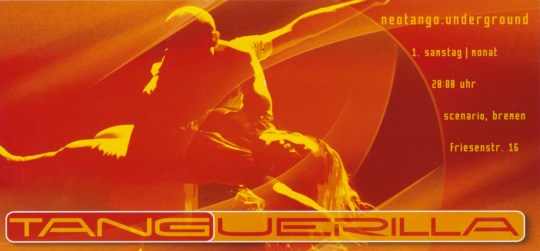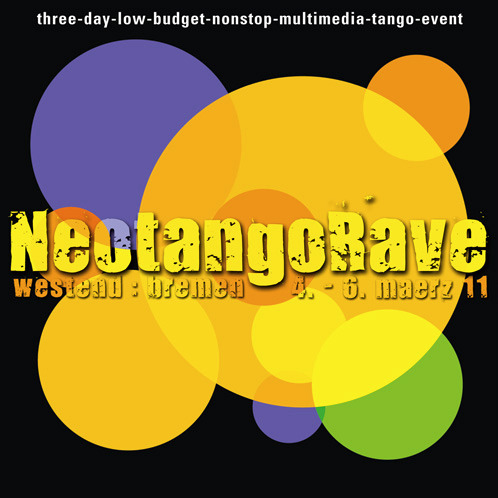»Tradition is not to preserve the ashes but to pass on the flame«
Gustav Mahler
Those who personally experienced the beginning of neoTANGO in 2001 know that the integration of Tango and contemporary music styles were its outstanding characteristics.
I am incredibly happy that I did not only experience the long history of Neotango right in front of my eyes, but also to be involved partly in shaping it with events. As I competely understand the result of not having experienced the origin and history of neoTANGO, let me call some developmental milestones to convey an idea of this period.
First Tanguerilla 2004
This is the first Tanguerilla flyer from 2004 calling the music neotango.underground.

First Tanguerilla video
This is my first playlist from 2003 containing 4,7% Alternative and the rest neoTANGO.
Tanguerilla-Playlist.pdf
Nothing has changed since then 😉
First NeotangoRave 4 – 6 March 2011

ORIGINAL announcement:
»DJs:
electrotango / veronika fischer / augsburg
nontango / tom schröder / hannover
tangofusion / sonja armissen / münchen
balkantango / arlenka klas / feldkirch
trancetango /volker marschhausen / bremen
Vjs: ReD Tango / berlin-france und volker marschhausen / bremen«
This is the proof that from beginning of the NeotangoRave 80% of it’s DJanes played subgenre of Tango mixed with contemporary music styles. They preferred Tango DNA instead of Electro, Balkan, Fusion and Trance.
Crucial change – extinction of orchestras
The comfortable situation changed abruptly in 2012, when species extinction of most leading Neotango bands started and the musical support of DJanes ceased. The dissolution of Gotan Project in May 2012 created a domino effect on the most important NeoTango bands (NarcoTango, Gotan Project, Otros Aires) and dramatically decreasesd live concerts of others (Bajofondo, ElectrocuTango, Tango Crash, San Telmo Lounge, ETango).
Birth of Alternative
The musical scarcity of resources forced many DJanes to search for musical alternatives beyond Tango influences. Depending on personal preferences and musical influences, the entire spectrum of contemporary music styles slipped into their playlists. World, Hip Hop, TripHop, Classic Crossover, Rock, Blues, Dubstep, Ethno – everything became part of their selection, as far as the songs were considered as »danceable«.
That was the birth of todays mainstream Alternative DJ style, unfortunately taking over the term »Neotango«.
I don´t have any serious reservations about DJanes preferring »Alternative Music«. It’s a matter of their individual, personal taste and there will be a majority of DJanes serving »Alternative Music« at future events, including NeotangoRave. Additionally there are a lot of dancers, who like to improvise to this specific style.
Neotango is Neotango
But we should call a »spade a spade« Neotango is Neotango and Alternative is Alternative.
Or with other words as Philippe Cohen Solal indicated:
»With Gotan Project, the territory is tango, dance meets tango. So don’t expect us tomorrow to do reggae, or something like this. Gotan is tango, and we will stay in that territory… But we will sometimes take the freedom to bring tango out of its territory.«
neoTANGO is not a new, completely different epoch of tango, which is fundamentally different from tango and eclipses everything that has been done before. It is in the evolution of the tango simply its presently most advanced status in musical, dancing and social terms.
However, this evolutionary development does not take place at a constant speed, but in leaps and bounds, in which completely new elements are added to the tango. They give the tango a radically altered, contemporary appearance for a certain period of time, which is perceived as a consistent epoch.
The next step in tango evolution
In this sense neotango is by its nature the avant-garde of tango. It is the most advanced part of the respective contemporary tango and at the same time the driving force for the tango as a whole.
And to return to the starting point. Even the so-called “electro-tango” is only one, but incredibly important period in the history of the tango. It was revolutionary in its time and had an invaluable function in breaking up the encrustations of the dominant classical tango.
But this period also came to an end and did not lead to the end of Neotango in total. Rather, it led into a new epoch. This current period is more heterogeneous and is characterized by parallel developments and diversified communities. But this is also the merit of the so Electrotango, because it was the precondition for this opening to innovation and new development. Like every revolution it acted as a door opener.
I believe that we are currently in a situation similar to that of the Epoca de Ora. There are many different streams of Tango that are competing with each other in a fruitful way and thus keep the tango alive.
You can explore their diversity at neoTANGO Music group with videos of about 200 contemporary Tango orchestras.

